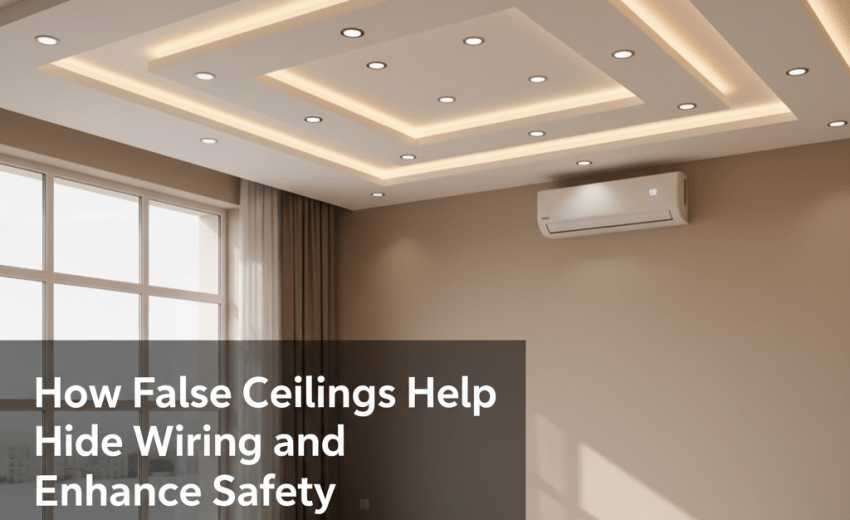
Table of Contents
False ceilings have become an integral part of modern interior design, offering both visual appeal and practical advantages. Among their many benefits, one of the most important is how they help conceal wiring and improve overall safety in homes, offices, and commercial spaces. Beyond aesthetics, False ceilings play a vital role in creating organized, clutter-free environments that reduce the risk of electrical hazards while maintaining a polished, professional appearance.
The Aesthetic and Functional Power of False Ceilings
A False ceiling, also known as a drop ceiling or suspended ceiling, is a secondary ceiling installed below the main structural ceiling. It’s commonly made from materials like gypsum, POP (Plaster of Paris), aluminum panels, or PVC. While its primary role may seem decorative, it serves an essential purpose—providing a hidden space to neatly route electrical wires, lighting fixtures, air-conditioning ducts, and other utility lines.
This hidden compartment not only keeps cables out of sight but also contributes to a cleaner, more streamlined look. In modern architecture, where minimalist designs and sleek finishes are favored, False ceilings have become a must-have feature for achieving that seamless finish.
Concealing Wiring: Clean and Safe Interiors
Electrical wiring can quickly become an eyesore if left exposed. Whether it’s for lighting, air conditioning, or internet connectivity, today’s homes and offices rely on extensive cabling. A False ceiling provides the perfect solution by creating a concealed cavity where wires can be safely organized and distributed throughout the space.
Beyond hiding clutter, this approach enhances safety. Exposed wires can deteriorate over time, get tangled, or pose a fire hazard. When enclosed within a False ceiling, cables are protected from dust, moisture, and accidental damage, significantly reducing the chances of electrical malfunctions.
Enhancing Fire Safety and Heat Resistance
Safety is one of the most important reasons to install a False ceiling. Many modern ceiling materials, such as gypsum and mineral fiber boards, are designed with fire-resistant properties. These materials can prevent the spread of flames and protect the wiring system in case of a short circuit.
Additionally, False ceilings act as a thermal barrier. They help regulate room temperature by reducing the heat that travels from the roof or upper floors, thereby maintaining a comfortable indoor environment. This combination of heat resistance and electrical protection makes them a smart investment for safety-conscious property owners.
Energy Efficiency and Acoustic Benefits
A False ceiling does more than just hide wiring—it also helps in conserving energy. By reducing the ceiling height, it minimizes the volume of air that needs to be cooled or heated, leading to better energy efficiency and lower electricity bills.
Moreover, False ceilings can significantly improve acoustics. They absorb sound and reduce noise levels, making them ideal for offices, classrooms, and entertainment spaces. When combined with proper insulation materials, they contribute to a quieter, more peaceful environment.
Easy Maintenance and Accessibility
Another practical benefit of False ceilings is the ease of maintenance. The space between the main ceiling and the False ceiling provides easy access for repairs or upgrades. Electricians and technicians can open specific panels without damaging the entire ceiling, making it simple to modify wiring systems or install new fixtures.
This accessibility ensures that your electrical system remains safe, organized, and adaptable to future technology needs.
Design Versatility and Lighting Enhancement
False ceilings are not just about function—they also elevate the visual appeal of a room. Designers often integrate LED strip lights, recessed lighting, or cove lighting within False ceilings to create stunning visual effects. The hidden wiring allows lights to shine beautifully without visible clutter, adding a luxurious ambiance to any space.
From modern minimalism to ornate traditional designs, False ceilings can be customized to complement any architectural theme, offering a perfect balance of beauty and practicality.
Sustainability and Modern Living
With sustainability becoming a major concern in construction, False ceilings contribute by enhancing energy efficiency and supporting eco-friendly lighting systems like LEDs. They also help distribute lighting more effectively, reducing the need for excessive fixtures and lowering energy consumption.
Conclusion
False ceilings go far beyond decoration—they are a cornerstone of modern interior safety and efficiency. By concealing complex wiring systems, enhancing fire resistance, improving acoustics, and promoting energy savings, they serve as both a protective and aesthetic feature. Whether you’re designing a residential space or a commercial property, installing a False ceiling is a smart way to achieve elegance, safety, and functionality in one solution.
Ready to Build with Confidence?
Get in touch with Charminar to learn how our project management expertise can streamline your next development.
📧 contact@bluediamondfm.com
📞 +971 56 705 4223
🌐 https://charminardubai.com/
Frequently Asked Questions (FAQ)
What materials are best for False ceilings?
Gypsum, Plaster of Paris (POP), aluminum panels, and PVC are among the most popular materials, each offering durability, fire resistance, and design flexibility.
Are False ceilings safe for electrical wiring?
Yes. False ceilings provide a safe and enclosed space for wiring, protecting cables from exposure, damage, and reducing the risk of short circuits or electrical fires.
Do False ceilings help reduce electricity costs?
Absolutely. By lowering the ceiling height and improving insulation, False ceilings reduce energy usage for air conditioning and lighting, leading to noticeable savings.
How long does a False ceiling last?
With proper installation and maintenance, False ceilings can last 15–20 years or more, depending on the materials used and environmental conditions.
Can False ceilings be customized for any room?
Yes. False ceilings can be designed for any space—living rooms, offices, hotels, or commercial complexes—and tailored to suit lighting, color, and style preferences.





